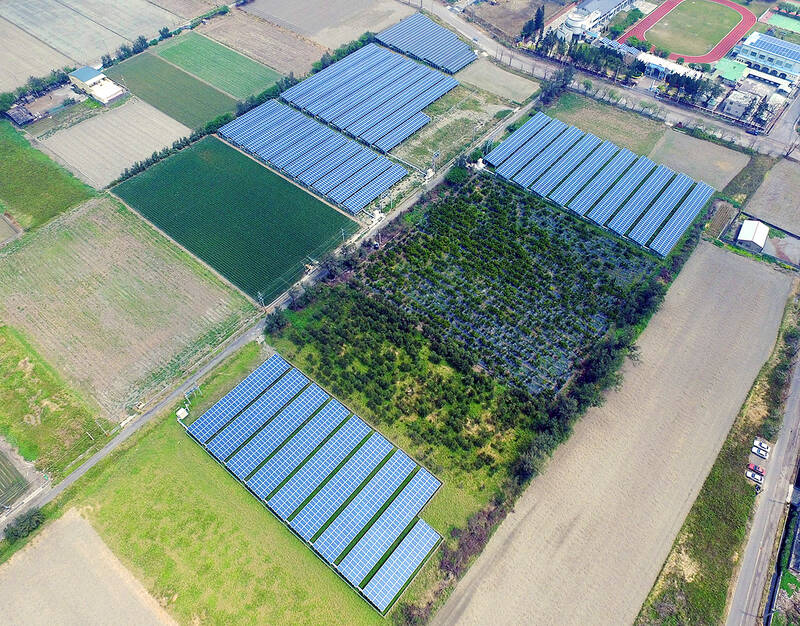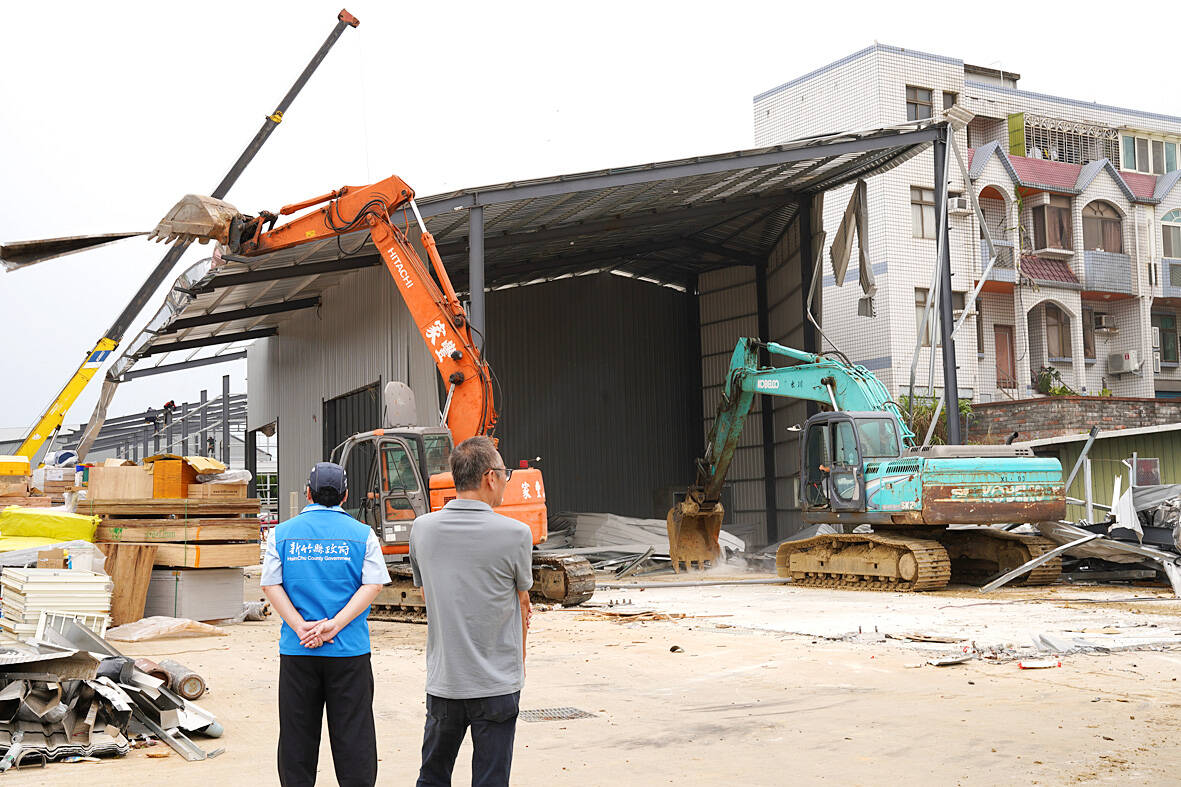A recent report by TaiwanPlus presented a widely believed factoid about solar photovoltaic (PV) power farms: “they take precious land away from agriculture.” Similarly, a Reuters piece from August last year contends that agricultural land in Taiwan is precious and that “there is little room for sprawling wind and solar farms, which take up significantly more space than conventional energy sources.”
Both of Reuters’ claims are false. There is plenty of room in Taiwan for all the renewable energy systems we need. Our problem is not a lack of land, but Taiwan’s crazed land management policies and programs.
An excellent October 2017 piece in AmCham Taiwan by longtime Taiwan hand Timothy Ferry lays out some of the numbers. Ferry writes that an “installed solar capacity of 20GW would likely require 20,000 to 25,000 hectares of land — nearly 3 percent of Taiwan’s total 800,000 hectares of arable land.” That 20GW, the government goal for 2025, represents a significant chunk of Taiwan’s current installed capacity of around 55GW of power from all sources.

Photo: Chang Hui-wen, Taipei Times
FARMLAND DESTRUCTION
Imagine if Reuters had presented another kind of dichotomy, equally false, but more illuminating: solar power competes with illegal factories for agricultural land. After all, the 25,000 hectares cited above is roughly equivalent to the 13,000 hectares of farmland occupied by illegal factories and warehouses in Taiwan, according to a report in this paper in 2017.
Even the illegal factories are only the tip of the spear of farmland conversion in Taiwan. Each year farmland is lost to gravel operations, residences, industrial parks and other structures, all with varying levels of legality. At least those are useful: recall that religious structures occupy thousands of hectares of agricultural land, but no one ever writes that this is a problem, let alone that they compete with solar power.

Photo: Liao Hsueh-ju, Taipei Times
Solar is thus merely a single item among many that may take farmland.
This widespread destruction of Taiwan’s farmland has its roots in the general easygoing illegality of things so prevalent in Taiwan, but it became implicit government policy with Taiwan’s accession to the WTO in 2002. To join, Taiwan was forced to import rice. This compelled the government to let fields lie fallow, up to 50,000 hectares by some estimates. By 2012, this figure had risen to over 200,000 hectares.
In 2018, of Taiwan’s roughly 800,000 hectares of farmland, only 540,000 actually produced a crop. Clearly, in addition to hosting structures, tens of thousands of hectares lie fallow, far more than would ever be needed for solar PV development.

Photo: Liu Yu-ching, Taipei Times
The existence of large acreages of fallow land is an irresistible temptation to land developers.
FALSE TRADEOFF
Taiwan also reduced agricultural subsidies and land planted with corn for animal feed to raise its imports of feeds for the WTO, returning feed production to 1960s levels. Today the island is dependent on imported feed for meat production.
As scholars observed two decades ago, the government’s goal thus shifted from promoting food self-sufficiency to demand-supply balancing. This is important because the conventional idea of a solar-farmland tradeoff is a visceral but primitive dichotomy rooted in the idea of farmland as food security insurance.
Indeed, in July of 2020 the Council of Agriculture (COA), driven to panic by this perception, sent down a drastic new regulation making it illegal to install solar systems on farms smaller than two hectares. The solar PV market in Taiwan took a huge hit.
The truth is that Taiwan now depends on its participation in global trade networks for food security. It cannot supply its own population. Even if all 800,000 hectares were put back into production, Taiwan could not be fed. A solar-food tradeoff thus does not exist, because the amount of food lost to solar PV would be marginal compared to Taiwan’s overall food imports. Ironically, Taiwan Semiconductor Manufacturing Co’s (TSMC) export prowess is probably a more important factor in Taiwan’s food security than all the island’s farmland.
Other government policies and regulatory stances tacitly encourage farmland conversion, legal and illegal. Agricultural land has been untaxed since 1987.
If illegal factories occupy it, they not only pay taxes themselves, but encourage the sprouting of other businesses nearby that also pay taxes, a boon to Taiwan’s perennially strapped local governments. Hence, illegal farmland development is often winked at by local regulators.
Further, the size of farms is slowly falling over time, meaning that farmers find it increasingly difficult to take advantage of scale economies to upgrade technology and management, even as farmers continue to age. It is thus generally more lucrative for aging small farmers to deal for the land than farm it. Government policies to address these issues are largely failures.
THE REAL PROBLEM
Hence, commentary about the alleged competition between solar PV and land obscures the real competition, which has historically been the colonial system of funding Taipei’s development by starving the rest of Taiwan, especially rural areas. Relentless conversion of agricultural land is just fallout from that.
Because agricultural land is not taxed, effectively the government regulates land by zoning it. Both the central and local governments attempt to shape farmers’ crop choices, but this is generally aimed at demand-supply balancing, not food security as such.
Moreover, there are no programs to integrate urban areas into this system, such as a “Victory Garden” program under the rubric of civil defense. Indeed, in many new residential communities, the familiar small gardens in patches of soil and vegetable growing in styrofoam containers are forbidden by neighborhood agreements that seek to make the houses “beautiful.”
Nor does the government appear to base its crop decisions on the quality of the food supply relative to the land used, though that should be a vital issue in food security.
For example, rice remains the dominant starch, but Taiwan could probably obtain more calories from tubers. Concern about food security should also drive questioning of Taiwan’s food processing choices, such as milling nutritious brown rice into white. That has a much greater effect on Taiwan’s available nutrients than solar PV farms.
Presentations in the media too often feed the false idea that solar power consumes farmland in exorbitant quantities (laudably, the TaiwanPlus I cited earlier is about a company working to change that perception).
Such drama has to stop if Taiwan is to meet its renewable energy goals. The real problems lie in the central government’s policies and attitudes toward land and crop management.
After all, harvesting sunlight is a kind of farming, too.
Notes from Central Taiwan is a column written by long-term resident Michael Turton, who provides incisive commentary informed by three decades of living in and writing about his adoptive country. The views expressed here are his own.

Taiwanese chip-making giant Taiwan Semiconductor Manufacturing Co (TSMC) plans to invest a whopping US$100 billion in the US, after US President Donald Trump threatened to slap tariffs on overseas-made chips. TSMC is the world’s biggest maker of the critical technology that has become the lifeblood of the global economy. This week’s announcement takes the total amount TSMC has pledged to invest in the US to US$165 billion, which the company says is the “largest single foreign direct investment in US history.” It follows Trump’s accusations that Taiwan stole the US chip industry and his threats to impose tariffs of up to 100 percent

On a hillside overlooking Taichung are the remains of a village that never was. Half-formed houses abandoned by investors are slowly succumbing to the elements. Empty, save for the occasional explorer. Taiwan is full of these places. Factories, malls, hospitals, amusement parks, breweries, housing — all facing an unplanned but inevitable obsolescence. Urbex, short for urban exploration, is the practice of exploring and often photographing abandoned and derelict buildings. Many urban explorers choose not to disclose the locations of the sites, as a way of preserving the structures and preventing vandalism or looting. For artist and professor at NTNU and Taipei

In the run-up to World War II, Admiral Wilhelm Canaris, head of Abwehr, Nazi Germany’s military intelligence service, began to fear that Hitler would launch a war Germany could not win. Deeply disappointed by the sell-out of the Munich Agreement in 1938, Canaris conducted several clandestine operations that were aimed at getting the UK to wake up, invest in defense and actively support the nations Hitler planned to invade. For example, the “Dutch war scare” of January 1939 saw fake intelligence leaked to the British that suggested that Germany was planning to invade the Netherlands in February and acquire airfields

The launch of DeepSeek-R1 AI by Hangzhou-based High-Flyer and subsequent impact reveals a lot about the state of the People’s Republic of China (PRC) today, both good and bad. It touches on the state of Chinese technology, innovation, intellectual property theft, sanctions busting smuggling, propaganda, geopolitics and as with everything in China, the power politics of the Chinese Communist Party (CCP). PLEASING XI JINPING DeepSeek’s creation is almost certainly no accident. In 2015 CCP Secretary General Xi Jinping (習近平) launched his Made in China 2025 program intended to move China away from low-end manufacturing into an innovative technological powerhouse, with Artificial Intelligence